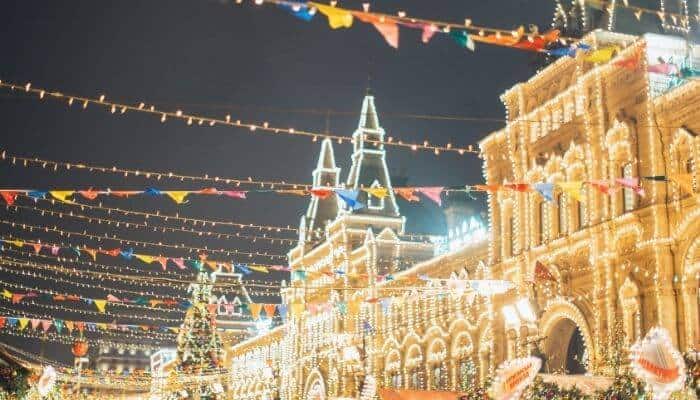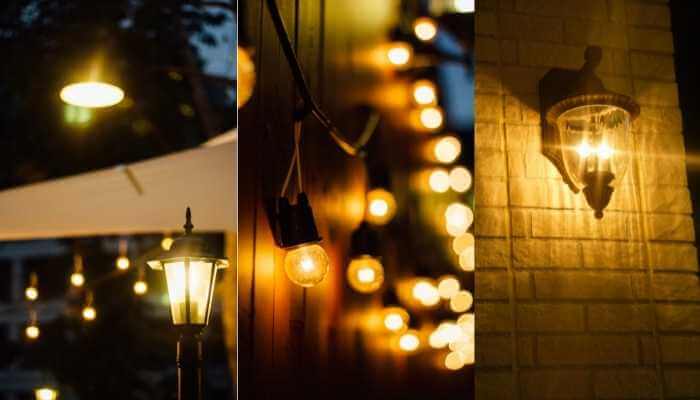Want to add a warm, comforting glow to your outdoor space? Perhaps it’s time to use stringed lights? Now, you can go with hanging filament lights for the larger spaces, but what about smaller spaces? Especially beneath a covered patio or umbrella, why not use fairy lights?
Fairy lights are lights set on a thin power cord spaced fairly close together from beginning to end. Due to their small size, fairy lights use up to 70% less energy and have a longer life span than traditional light bulbs.
I took the rabbit hole into fairy lights and everything I could find out about them is here. Just keep reading!
Are Fairy Lights Christmas Lights?
Fairy lights are small lights on a cord that are spaced fairly close together. This kind of light has been used for Christmas decorating for years. It certainly stands to reason that the holiday they’re most used for winds up branding them.
But I tend to think of fairy lights as a smaller version of Christmas lights. To me, fairy lights are smaller and they provide ambient lighting effects that work almost like artwork. You use them for the opposite reason of Christmas lights. You use them to accentuate the beauty around them and not to steal the show.
Why Did Fairy Lights Become Popular?
Besides the decorative and light value of fairy lights, these lights are also not as power-hungry as other lights. Most string lights these days are manufactured using energy-efficient LED lights. They use up to 70% less energy and last many times longer than normal bulbs.

Add this to the fact that the bulbs were there to provide a certain aesthetic that usually reduces light noise and the savings only grows. Some fairy lights are run by battery, through USB rechargeable battery, or even using solar. All these methods of powering are a bit environmentally friendly and energy-efficient.
Fairy lights are also much safer than standard bulb lights or even larger string lights. They don’t get near as hot as standard bulbs. If you’re using rechargeable, battery, or solar fairy lights, you’ve taken the wall outlet out of the equation – lessening the risk of overheating via electrical output. The solar string lights are usually weatherproof and are perfect for your outdoor space.
If you consider Christmas lights the same as fairy lights, I suppose you could argue that the holiday made them popular.
What is the Difference Between Fairy Lights and String Lights?
I tend to think of fairy lights as a form of string light. When I think of string lights, I imagine a cable from which bulbs are hung. They might be small bulbs or larger Edison bulbs, but there are always multiple bulbs spaced apart at intervals on the electrical cord. Hence “string lights”.
What sets fairy lights apart from string lights (other than the size) is the usage. These lights are used more for decoration than for actually lighting anything. They are generally flexible and can add a decorative light showcase wherever you want.
I’ve seen string lights and fairy lights used interchangeably by even decorators. But, in my opinion, the difference is legitimate. You’d need to use quite a lot of fairy lights to achieve the same amount of lighting as two simple strands of string lights.
What Are Some Uses for Fairy Lights?
Both fairy lights and string lights generate a very cozy atmosphere wherever they’re used. They can be hung around a patio cover, or using posts around the patio. Most often string lights accomplish the main lighting in an area and fairy lights can be strung through and around them.
Fairy lights strung up tree trunks and around planters and vases can lend an artistic vibe to a place.
If you have pieces of art or window frames or framed shapes, letters, symbols, etc? Attaching fairy lights or wrapping fairy lights around the framing can change the look of not only your frame but the area around it. Again – these lights make something normal into a work of art or highlight your art. Either way, the outcome is always nice.
Using fairy lights in this way is the opposite of placing them to just add a lighting aesthetic. In this case, what you hang fairy lights on becomes a feature in the setting you’re in.
How Can I Incorporate Fairy Lights Into My Outdoor Space?
Fairy lights really accentuate the beauty already present and add a layer of cheer and peace to an area. They aren’t intrusive and can be considered relaxing and cozy, even. Therefore using them as I mentioned above to be an accent to brighter lights already there works wonderfully.
Some of these little lights are made to create curtains of lights you can hang from the sides of your gazebo or you can lay across the top bars of a pergola. During the hot seasons, when you’re not using your fire pit or fire table, you can put these lights in that space instead to give the same kind of light without the heat.
Do you have a particularly dark area where you have a path or a set of stairs? You can wrap fairy lights around the railing of the stairs or you can string the fairy lights along your path to help provide a guide and lighting.
And what about task-lighting in areas where you don’t need a lot, but just enough to see what you’re doing? Fairy lights can be strung up in a cooking area, near the prep station for a grill, or your version of an outdoor kitchen (don’t get me started on the hassle and cost saved if you use fairy lights instead of under-cabinet lights in an indoor kitchen).
They can hang from a pergola, wrap around the legs of your outdoor shelter, or be strung from the roof of the shelter. Some places string them in a square above an outdoor seating area and then string them back and forth across those lines to make a checkerboard of fairy lights. The ambiance from using these lights is magical.
Maybe that’s why they’re called Fairy Lights!
If you are looking for other lighting ideas for your outdoor space then be sure to check out my best outdoor lights article here.













